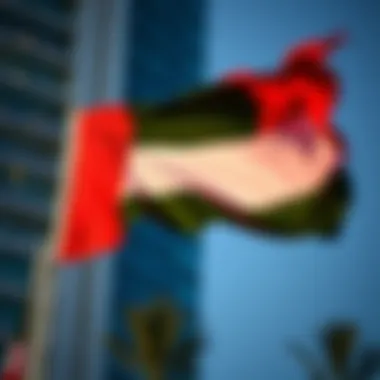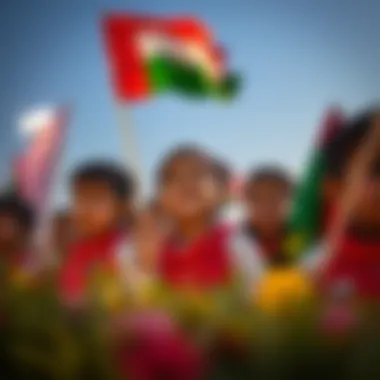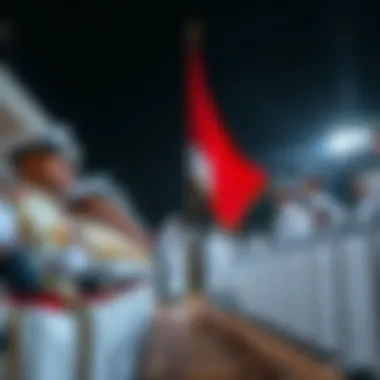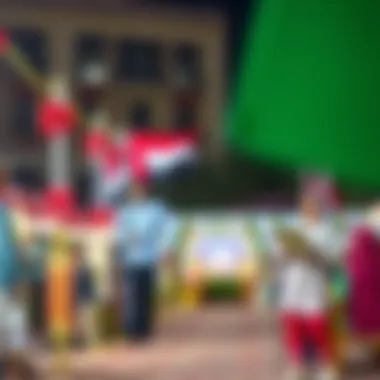Understanding Flag Day in the UAE: A Cultural Tribute


Intro
Flag Day in the United Arab Emirates stands as a poignant reminder of the nation’s unity, heritage, and unfolding narrative. This celebration takes place annually on November 3rd, marking the day when the UAE flag was officially raised for the first time in 1971 after the union of the seven emirates.
The UAE flag, a tapestry of colors and symbolism, embodies the aspirations and identity of its people. Each hue in the flag has its significance: red represents bravery, green for hope, white signifies peace, and black embodies strength. By understanding these colors and their meanings, one can grasp how Flag Day not only stirs national pride but also encourages a collective reflection on the nation's journey.
In this article, we will explore the rich historical context of Flag Day, delve into its cultural significance, and examine the splendid ways Emiratis and residents celebrate this day across cities like Dubai and Abu Dhabi. We will also discuss how educational institutions and media are pivotal in fostering an awareness of this day, ensuring that its importance is passed down through generations.
In examining the diverse activities—from official ceremonies held by the government to grassroots community events—we will capture the essence of what Flag Day means to various groups in the UAE. Furthermore, we’ll look into how this day reinforces not just a sense of identity but also a spirit of unity and resilience among the Emirati people.
Through this exploration, readers will gain insights into a day that resonates deeply with the hearts of many, offering a greater appreciation for the cultural tapestry that makes up the UAE's national identity.
Historical Context of Flag Day
The celebration of Flag Day in the United Arab Emirates stands as a poignant reminder of the nation’s identity and rich history. Understanding this day requires a look back into the very foundations of the UAE itself. The significance of Flag Day is deeply rooted in the events that shaped the country's formation and the subsequent adoption of its national flag.
Formation of the United Arab Emirates
On December 2, 1971, the UAE was officially formed from a collection of seven emirates, formerly known as the Trucial States, which had been under British protectorate. This historical merging of the emirates was no small feat; it required a delicate negotiation among local rulers who recognized the need for unity to strengthen their collective economic and political standing. The founding fathers, notably Sheikh Zayed bin Sultan Al Nahyan, played pivotal roles in fostering this alliance. The collaboration was driven by a vision of national progress, security, and cultural development.
Creating a unified identity was paramount for these newly partnered states. The formation of the UAE wasn’t merely a political maneuver; it symbolized a shared destiny for the different tribes and groups residing within its borders. This momentous occasion marked the establishment of a nation that values its diversity while celebrating common heritage. Thus, Flag Day represents more than just the physical banner that waves across the nation.
It symbolizes the bond between each emirate and the collective aspiration toward growth and prosperity.
Adoption of the National Flag
The national flag of the UAE was adopted on December 2, 1971, the same day as the country's formation. The flag’s design is rich in meaning and reflects various historical and cultural aspects that resonate with the identity of the Emirati people. The colors of the flag—red, green, white, and black—hold significant connotations:
- Red represents courage and bravery, reflecting the battle for independence.
- Green symbolizes hope, joy, and the lushness of the country’s landscape.
- White stands for peace and honesty, ideals that the nation seeks to uphold.
- Black is a nod to strength and resilience in the face of adversity.
These colors are drawn from Pan-Arab colors, signifying unity among Arab nations. The flag’s design was the result of a national competition, which showcased the creativity and enthusiasm of the citizens. The selected design was created by a young Emirati, which underscores the importance of individual contributions to national identity.
As people across the UAE gather each year to celebrate Flag Day, the flag itself becomes a unifying force, reminding citizens and residents alike of their shared values and mutual aspiration for a brighter future.
"The flag is not just a piece of cloth; it is the very essence of our identity, a symbol that binds us together as a nation."
Understanding the National Flag
The national flag of the United Arab Emirates is a powerful symbol that embodies the unity and heritage of the nation. Its vibrant colors and unique design tell a story of cultural significance and national pride. Understanding the banner's elements is not just an academic endeavor; it’s essential for grasping the spirit of the UAE and what it represents to its people.
When one looks at the flag, each color has a specific meaning that connects to the identity of the Emirati people and their aspirations. A discussion about the flag goes beyond mere design; it invites an appreciation for the values and history that it encapsulates. This section delves into two vital aspects: the symbolism of the colors and emblems, followed by the intricate design process and selection.
Symbolism of Colors and Emblems
The UAE's flag consists of four colors: red, green, white, and black. Each hue is steeped in meaning, reflecting the foundation of the nation.
- Red symbolizes bravery and courage. It captures the spirit of the Emirati willingness to defend their homeland.
- Green signifies hope and prosperity. A nod to the plentiful resources and the lush landscapes that the country aspires to nurture.
- White represents peace and cleanliness, a reminder of the community's value for harmony and goodwill among its people.
- Black symbolizes strength and resilience, reflecting the spirit of perseverance in the face of challenges.
Moreover, the flag's design features a vertical red stripe alongside three horizontal bands of green, white, and black. This layout not only makes it visually distinctive but also resonates with the Pan-Arab colors, reinforcing a sense of shared history with other Arab nations.
"The UAE flag is more than a piece of cloth; it is an emblem of hope, pride, and the spirit of the people who call this land their home."
Design Process and Selection
The journey to the current design of the UAE flag was collaborative and thoughtful. In 1971, the flag was chosen as part of a national competition, highlighting the active participation of the Emirati public. The entries were evaluated not only for aesthetic appeal but also for the deeper meanings they conveyed about the nation.


The design was ultimately crafted by a young Emirati named Abdullah Mohammed Al Maainah, whose vision captured the essence of a nation that was just beginning to carve its identity. His creation not only fulfilled the requirements of visual harmony but also connected deeply with the national narrative of unity and strength.
Understanding this process sheds light on how the flag serves as a collective emblem for all citizens, fostering a shared sense of belonging. It reminds the people of the rich tapestry of traditions and aspirations that go into nation-building. Ultimately, the flag stands as a testament to the UAE's journey and unity, encouraging all who reside within its boundaries to appreciate and celebrate this identity.
Official Observances of Flag Day
The official observances of Flag Day in the United Arab Emirates play a pivotal role in reinforcing national identity and pride. Established to celebrate the rich heritage and aspirations encapsulated by the national flag, these observances form a framework that brings together citizens, residents, and the government in a unifying celebration. This is not just a day marked on the calendar; it is a heartfelt tribute to the nation's values and cultural significance.
Ceremonial Activities
Ceremonial activities are at the heart of Flag Day observances, showcasing the UAE’s heritage through various forms of expression. Throughout the country, public institutions, schools, and governmental organizations engage in a variety of events that highlight this unique day.
- Flag Raising Ceremonies: Schools and government buildings traditionally organize flag raising ceremonies at noon, symbolizing the height of national pride. These gatherings often feature the national anthem, speeches from dignitaries, and student performances, creating a lively tapestry of patriotic fervor.
- Cultural Festivals: Many communities host cultural festivals that incorporate traditional music, dance, and art, all revolving around the theme of the flag. Local artists may showcase their work, reflecting the flag's colors and the spirit of the nation.
- Parades and Marches: Major cities like Abu Dhabi and Dubai often witness parades featuring various community groups, military displays, and floats decorated in national colors. Citizens of all ages participate, displaying a collective sense of pride and unity.
These activities not only celebrate the flag but also provide a platform for community engagement, allowing citizens to reflect on their national identity in a meaningful way.
Government Involvement and Statements
Government involvement in Flag Day is profound and deeply symbolic. Statements made by high-ranking officials illuminate the occasion's resonance with national values and aspirations. Every year, messages are conveyed through speeches and social media posts, often reiterating themes of unity, tolerance, and loyalty to the nation. This kind of engagement helps to embed the significance of the flag into the everyday consciousness of citizens.
- Official Statements: Ministers and leaders issue statements emphasizing the importance of the flag as a symbol of heritage. For instance, the President of the UAE may address the nation, reminding citizens of the sacrifices made for freedom and the collective vision for the future.
- Collaborative Programs: The government encourages partnerships with private sectors and NGOs to enhance the celebrations. These collaborations can lead to community outreach programs that include educational activities about the flag’s history and significance, thereby reinforcing a sense of belonging among various demographics.
"The flag embodies our shared history, values, and hopes for the future. Celebrating Flag Day is a way of honoring those who have come before us and the future we build together."
By integrating observances into the realm of national dialogues and encouraging participation among citizens, Flag Day becomes a powerful event that strengthens the social fabric of the UAE.
Community Celebrations
Community celebrations play a vital role in the observance of Flag Day in the United Arab Emirates. This day provides an opportunity for citizens and residents alike to come together, fostering a spirit of unity and national pride. Various events are organized across the country, showcasing not just the flag but also the rich tapestry of cultures within the UAE. Celebrations go beyond merely waving a flag; they symbolize a deeper connection to national identity.
Local Events and Festivals
Local events and festivals form the backbone of Flag Day celebrations. Each emirate hosts unique activities ranging from parades to cultural workshops. These gatherings are often spearheaded by local municipalities and community centers, which aim to engage citizens of all ages.
Participants can expect everything from traditional dances to art exhibitions that depict the history and significance of the national flag. For instance, in Abu Dhabi, a festival may include a showcase of local crafts, while Dubai might focus on high-energy performances accompanied by fireworks. Such events invite expatriates as well, creating an inclusive atmosphere where everyone can celebrate the shared values and heritage of the UAE.
Celebrations build community connections and strengthen the fabric of national identity.
In addition, these local events often include competitions, such as the best flag design or the most creative outfit incorporating the flag's colors. Schools and families join in these festivities, making Flag Day a heartfelt affair that resonates personally with attendees. Individuals often feel a sense of accomplishment and enthusiasm when their contribution, no matter how small, adds to the celebration's overall impact.
Role of Schools and Educational Institutions
Educational institutions further amplify the celebrations of Flag Day through a range of projects and activities. Schools across the UAE take this opportunity to instill a sense of patriotism and unity in their students. They organize events like flag-raising ceremonies where students participate in singing the national anthem and reciting poetry that honors the country. These activities help cultivate a sense of belonging among young learners.
Moreover, schools often incorporate lessons about the flag's history and the importance of national identity into their curriculum leading up to Flag Day. By doing so, children gain not only knowledge but also an emotional connection to the symbols of their country. Activities might also include art contests where students create representations of the flag, fostering creativity while simultaneously reinforcing national pride.
Furthermore, schools can collaborate with local organizations to facilitate community service initiatives that echo the flag’s ideals, such as unity and peace. Students engaging in cleanup drives or charity events assist in cementing the values that the flag represents, promoting civic responsibility among the youth. The role of schools thus serves as a critical element in nurturing the significance of Flag Day and ensuring that the spirit of the occasion carries forward to future generations.
Through these community celebrations, the UAE not only commemorates Flag Day but also underscores its significance in fostering unity, national pride, and a collective identity that transcends all boundaries.
Media Coverage and Public Awareness
The celebration of Flag Day is not merely a ceremonial observance; it hinges on broad media coverage and public awareness. How the media portrays this significant day plays a pivotal role in shaping perceptions about national identity in the UAE. Citizens and residents alike glean insights into cultural pride and the stories behind the flag through media channels they trust.
By covering Flag Day, traditional platforms contribute to the narrative that incites national pride and unity. Through news articles, broadcasts, and documentaries, the media provides context—historical, cultural, and emotional—that helps individuals connect with the flag on a deeper level. Such content also serves to educate the younger generation, reinforcing the flag’s significance as a national symbol.
Moreover, in a rapidly changing media landscape, the way information is disseminated can affect how engaged citizens feel about their heritage. With the growth of social media, the interaction between the public and the media expands, fostering grassroots campaigns and inclusive conversations. This evolution of media fosters a two-way dialogue about national identity, allowing the flag and its importance to emerge from solemnity into a lively, shared experience.


Coverage in Traditional Media
Traditional media, including newspapers, television, and radio, plays a critical role in Flag Day observances. Broadcasters often feature special programs that elaborate on the flag's history, the essence of national pride, and its role in unifying the diversity that exists in the UAE. News articles around this time often include personal stories of citizens reflecting on what the flag means to them, adding to its emotional weight.
Some popular outlets, such as Al Jazeera and Gulf News, dedicate entire segments in their news broadcasts during this time to highlight national celebrations, public ceremonies, and interviews with officials who share insights into the significance of Flag Day. Events like children drawing and painting competitions tied to the flag's image are frequently showcased, thus engaging families and communities and making the celebration more relatable.
Benefits of Coverage in Traditional Media
- Educational Context: A deeper understanding of the flag's history and symbolism.
- National Engagement: Building a community around shared values.
- Personal Connectivity: Strengthening individual bonds with national identity through storytelling.
Specific examples include the extensive coverage during Flag Day, where citizens are called to participate in parades and flag-hoisting ceremonies. Many television channels provide live coverage of these events, allowing those unable to attend in person to share in the experience.
Role of Social Media in Celebrations
In the digital age, social media serves not only as a platform for personal expression but also as a significant vehicle for public engagement during Flag Day. UAE citizens leverage platforms like Twitter and Instagram to share their experiences, showcasing how they celebrate this important occasion.
On social media, hashtags such as #UAEFlagDay trend annually, creating a surge in activity around the date. Users post pictures of flag decorations, personal reflections, and events attended, forming a rich tapestry of content that enhances public awareness. These digital interactions encourage others to share their stories and create a sense of solidarity, fostering a contemporary collective identity.
Highlights of Social Media's Role
- Inclusivity: Amplifying voices from all demographics to participate in the national conversation.
- Real-time Updates: Sharing live updates during parades, ceremonies, and community activities.
- Educational Initiatives: Spreading awareness of educational campaigns focused on the significance of the flag.
Through social media, younger generations are not just passive consumers of information but active contributors to the narrative. They transform Flag Day from a formal observance into a lively exchange of ideas, photos, and messages shared around the globe, ensuring the flag's symbolism resonates deeply—even beyond national borders.
"Social media doesn’t just spread awareness; it helps define what Flag Day means for the new generation of Emiratis."
In summarizing the media's role, it becomes clear that both traditional and new platforms contribute uniquely to public awareness and celebration of Flag Day. Their combined efforts help enrich the understanding and appreciation of the national flag across generations, solidifying its significance in the UAE's identity.
Educational Campaigns and Initiatives
Flag Day in the United Arab Emirates is more than just a date on a calendar; it’s a profound opportunity to engage citizens and residents alike through educational campaigns that bolster national identity. These initiatives aim to connect the younger generation with the values and history reflected in the flag, promoting a sense of belonging and pride in the context of a diverse cultural landscape. The UAE, being a blend of tradition and modernity, utilizes such campaigns to ensure that the essence of its heritage is not lost amidst rapid development.
Promoting National Identity
The promotion of national identity through educational initiatives has become crucial in a country as dynamic as the UAE. By integrating the flag’s symbolism into school curriculums, students undergo a journey of discovery. They learn about not just the flag's colors—green for hope, white for peace, black for strength, and red for bravery—but also the stories behind them. For instance, schools often organize workshops and art competitions that resonate with the theme of Flag Day, enabling students to express their understanding and appreciation through creativity.
Transformative programs that involve field trips to historical sites or museums catalyze emotional and intellectual connections to the country. Such experiences illustrate the sacrifices made by past generations for the present freedom and security, reinforcing what the flag represents. In doing so, these campaigns foster a deeper awareness and appreciation of the nation’s rich tapestry.
Engagement Programs for Youth
Engaging the youth is paramount when considering the future of any nation. Programs focused on Flag Day often feature engaging activities designed to spark interest among the younger crowd. From poetry readings to storytelling sessions that revolve around the flag and national values, these initiatives cultivate a sense of ownership over the narrative of the nation.
In addition, community service projects are increasingly being tied into the celebrations of Flag Day. Initiatives such as beach clean-ups or volunteering at local shelters, adorned with the national colors, not only promote civic responsibility but also illuminate how unity under the flag can translate into collective action for the common good.
"Engagement programs for youth are not just about celebration; they’re about equipping them with the knowledge and experiences that will shape them into the responsible citizens of tomorrow."
Through such strategies, youth develop an emotional connection to the flag, moving beyond mere symbols to become active participants in the narrative of the UAE. These campaigns ensure that the essence of the flag as a symbol of hope and unity resonates deeply across generations, enriching the national consciousness and ensuring its relevance today and in the future.
The Flag in International Context
Flag Day in the United Arab Emirates is not only a moment of national reflection but also a significant marker of the nation's presence on the global stage. The UAE’s flag encapsulates more than just colors; it embodies unity, resilience, and the aspirations of its people.
Representation at Global Events
When the UAE participates in international events, be it cultural exhibitions, sports competitions, or diplomatic summits, the flag plays a pivotal role. It represents the nation’s identity and pride. For instance, during the Expo 2020 in Dubai, the UAE’s flag was prominently displayed. This not only showcased the country's rich culture but also its modernization efforts. Such events allow the UAE to cement its position as a leading player in the region and beyond, attracting global attention and business investment.


The flag symbolizes the country’s values, reminding the audience of its commitment to progress and peace. Flags are raised high during competitions like the Gulf Cooperation Council (GCC) games, creating an electric atmosphere and a sense of solidarity among athletes and supporters. The collective cheer for the flag often transcends sport, echoing broader themes of collaboration and cultural exchange among nations.
Symbol of Unity and Peace
Beyond national representation, the UAE's flag stands as a beacon of unity and peace. In times of global unrest, the UAE has often positioned itself as a mediator and peacekeeper. The flag serves as a reminder of the UAE's foundational values, which prioritize harmony over discord. By prominently displaying the flag in international corridors, the state communicates its dedication to fostering relationships built on mutual respect.
During United Nations gatherings, the UAE often emphasizes dialogue and collective conflict resolution. In such forums, the flag becomes a central symbol reflecting the nation’s commitment to humanitarian efforts. For example, the UAE has been at the forefront of numerous humanitarian missions, underpinning the idea that true strength lies in compassion and assistance to those in need.
"The UAE flag is a sign of our unity. In every thread, there’s a story of resilience and hope."
For further reading on the significance of national flags, visit Wikipedia or Britannica.
In a world filled with varied identities, the story of the UAE's flag serves as a powerful reminder of the collective ideals that can unite humanity.
Personal Reflections on Flag Day
Recognizing Flag Day in the United Arab Emirates is not just about the flag’s vibrant colors fluttering in the wind. It’s a deeply personal experience for many Emiratis and residents, encapsulating narratives that resonate with each individual’s journey within this diverse nation. Beyond the ceremonial forms, there’s a rich tapestry of personal stories that highlight the emotional significance of this day. These reflections can forge connections, often tying bonds within families and across communities.
Individual Experiences and Stories
Anecdotes about Flag Day often unfold around family gatherings. Many families come together, sharing stories about their ancestors and the sacrifices made for this day to hold meaning. One can find an elderly grandfather recounting tales from the past—how he watched the flag’s first fly, the flutter signaling a newfound hope for unity, independence, and identity. Such narratives transcend generations, allowing the youth to internalize the importance of the flag as a symbol of resilience and aspirations.
Take a moment to think about the little ones; they often express their joy through art. In classrooms, children take to crayons and paints, splotching colors of the UAE flag onto paper, creating their individual masterpieces. Their laughter fills the halls, and in these creative bursts, their connection is solidified, showing how the flag isn't just a piece of cloth but a living, breathing element of their identity. Teachers often encourage sharing personal draws and stories behind each stroke, leading to discussions about what the flag means at a personal level, thus nurturing a sense of belonging among students.
Each individual story weaves a part of the greater narrative of the UAE’s journey, making Flag Day a celebration of collective memories and personal connections.
The Emotional Connection to the Flag
The flag evokes feelings ranging from pride to nostalgia. For many, it stands as a monumental beacon of their identity—a reminder of the struggles, triumphs, and the ongoing evolution of the nation. When the flag is raised, it’s not simply about a national display; it’s the culmination of dreams, ambitions, and hopes of millions.
In the bustling streets, people adorn themselves with items displaying the flag—scarves, t-shirts, and even face paint—creating a moving sea of green, white, black, and red. This collective display stirs a sense of camaraderie. Every wave and flutter of the flag resonates emotions, stirring memories, and invoking a spirit of unity among all who call the UAE home.
Moreover, the emotional connection to the flag becomes even more profound when observed during significant milestones, such as the UAE’s National Day or events of global significance. These instances allow gatherings where people of all backgrounds come together, sharing their diverse stories while understanding a common thread through the flag. Such experiences unite everyone, reinforcing values of tolerance and respect prevalent in the UAE.
As people pause to reflect on their personal stories, memories tied to Flag Day, they inevitably recognize that the flag is more than a symbol; it's a vessel of emotions, dreams, and aspirations. Each fluttered wave mirrors the pulse of the nation and its people.
Ending: The Lasting Impact of Flag Day
Celebrating Flag Day is not just about waving fabric; it goes deeper, touching the core of national identity and unity among the people of the United Arab Emirates. The day serves as a reminder of the sacrifices made by the founding fathers and the journey of the nation toward progress. It is a time when citizens and residents alike reflect on their shared experiences, their aspirations, and the overall fabric that weaves together a diverse society.
As thousands gather to celebrate, we witness how the national flag becomes a symbol of courage and resilience. People sing the national anthem, wave flags, and participate in ceremonial events. Citizens feel a sense of pride as they reminisce about the UAE's accomplishments, ranging from economic prosperity to cultural milestones. Moreover, this sense of pride often translates into civic responsibility, urging individuals to contribute positively to national development.
Flag Day is not just an observation; it imbues the populace with a renewed sense of belonging and purpose. It nurtures the seeds of patriotism, weaving a rich tapestry that includes Emiratis and expatriates alike. It’s a day where differences fade, and common goals are highlighted, fostering an environment of inclusivity and camaraderie.
Reflecting on National Pride
National pride during Flag Day is a collective emotion, artfully blended with personal stories and shared narratives. It is visible in the enthusiasm shown during parades and public gatherings. Every face lighting up as they see the flag raised high echoes the verse: "Unity in diversity."
Some stories resonate more profoundly than others. Families may recollect moments that tie them to the flag—perhaps a first job, a wedding, or even a child’s birth. These stories woven into the larger fabric of Flag Day celebrations are what keep this tradition alive. Beyond governmental ceremonies, it is these individual connections that enrich the communal experience.
For many residents, especially expatriates, Flag Day serves as an opportunity to understand the Emirati way of life. The pride emulated through the celebrations can be a guide to understanding the deeper virtues of respect and communal harmony that the UAE embodies.
Future of Flag Day Celebrations
Looking ahead, the future of Flag Day celebrations seems promising yet challenging. As the UAE continues to grow and evolve, we can anticipate adaptations in the way Flag Day is commemorated.
For instance, digital platforms might expand involvement through virtual celebrations, allowing participation fully across communities. Live streaming and interactive programs could engage younger audiences, drawing their attention to the flag’s significance in today's context.
Moreover, educational initiatives could be enhanced. Schools might organize workshops or discussions, diving deeper into the flag's history, symbolisms, and its journey alongside the nation’s odes to unity and independence. Encouraging students to express their thoughts about what the flag means to them will help in fostering a generation that understands and cherishes their national identity deeply.
In summary, the lasting impact of Flag Day is multifaceted. It's a reaffirmation of national pride, an emotional bond between varied communities, and a preview of evolving traditions that promise to holistically incorporate the essence of the UAE's identity. The future may hold new ways of celebrating this pivotal day, but the core values will remain anchored in unity, pride, and a shared national journey.















